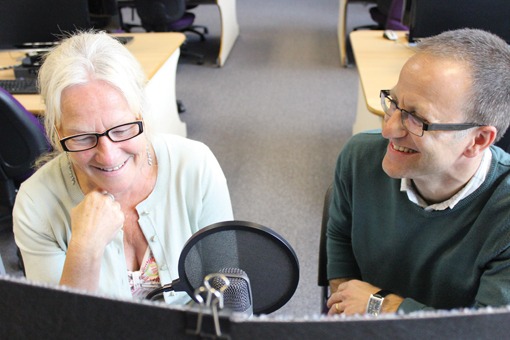Connect with audiences through Digital Storytelling
How do you create a digital story?
The best way to experience digital storytelling is to create your own. Our Digital Storytelling Masterclass explores the ideas and skills in depth over three days but you can get started by following some simple steps.
Writing a script
Find a story worth telling. This is the most important thing to get right. A digital story can look lovely but if the story doesn’t engage you’ll lose the audience. It doesn’t have to be a tear-jerker but give your audience a reason to care about the outcome.
All good stories talk about change in some way so think about the “before”, the “after” and then the journey between the two. What has changed and for whom?
Your story isn’t going to be long. Digital stories tend to last two to three minutes so you’ll have to be concise. If you’re telling a complex story, focus in on one aspect of it; a significant moment, a meaningful image or object or perhaps a key relationship. Tell a small story to make a big point.
Find a gripping first sentence to grab the attention and make sure your final words clearly signal the end of the story and leave it resonating in your audience’s mind.
We’d recommend reading your story to someone before you record it. Watch for their responses. When do they seem most interested? Does their attention wander at any point. Fine tune your script until you’re happy.

Selecting media
Recording a voiceover can be done simply and cheaply using Audacity, a free, open source piece of software that is easy to use. Pick a good quality microphone and record in a quiet place to avoid distracting background noises or ambience.
Images are an important element so spend time finding ones that are good quality and enhance your story rather than detract from it. If you have your own, brilliant! If not, then searching libraries like Flickr for Creative Commons licensed images is the next best thing. Remember to attribute the creators and abide by their license terms.
Sounds and music can also add an extra dimension but are difficult to get right. Freesound.org has an extensive community library of sound effects and Vimeo.com’s Music Store has a wide selection of good quality, Creative Common-licensed tracks.
Producing your video
Be prepared to spend a lot of time on the video editing! The aim here is to combine your voiceover and images but do it in a way that means all the different elements are working together for the purpose of the story.
Subtlety is the watchword. You will have a wealth of special effects and other enhancements at your fingertips. 95% of these look dreadful. You don’t want to write a powerful story then leave it reeking of cheese.
You could push the boat out and use professional software like Adobe Premiere or Final Cut to produce your story but that’s like using a sledgehammer to crack a very small nut. If you’ve never done video editing before Wevideo.com is a great place to start. It’s a free online tool that gives you all the features you’ll need for digital storytelling.
Sharing
Stories need to be told, even if it’s to just one person. Many people find it encouraging going through this process in a group of people they trust. Some storytelling can be very emotional and it’s important to make sure you don’t feel too vulnerable.
If you want share you’re story more widely, sites like Youtube or Vimeo are ideal but make sure that all media you’ve used in your story is properly attributed before publishing.
Then try it all again! Good storytelling is a skill that gets better with practice. Each time you try it you’ll learn something new. We’ve been doing this for several years now and we’re still discovering more areas to explore.
Chris Thomson
www.netskills.ac.uk/

 Learning on Screen
Learning on Screen